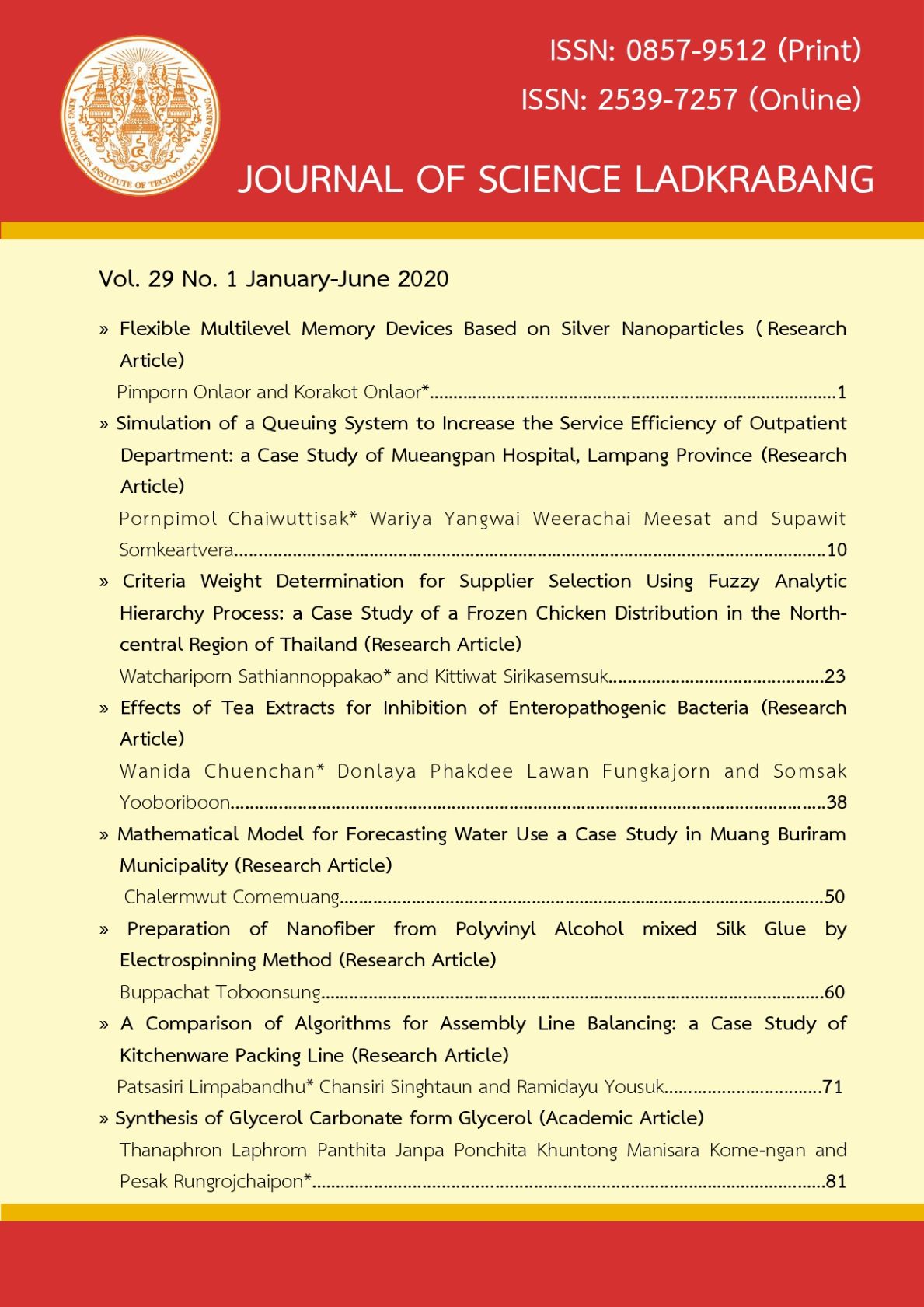Effects of Tea Extracts for Inhibition of Enteropathogenic Bacteria
Main Article Content
Abstract
The objective of this research was to study the antimicrobial effect of crude extracts obtained from white tea, green tea, black tea and oolong tea against bacteria causing gastrointestinal diseases including; Staphylococcus aureus, Escherichia coli, Salmonella typhi, Shigella flexneri, Klebsiella pneumoniae and Pseudomonas aeruginosa. Agar well diffusion technique was used for cell enumeration and minimum bactericidal concentration (MBC) was determined. The results showed that S. aureus, P. aeruginosa, S. flexneri and S. typhi were inhibited by white tea, oolong tea and green tea extracts at same concentration. Inhibition zone diameter of white tea extract of S. aureus, P. aeruginosa, S. flexneri and S. typhi were 31.50±0.50, 15.50±0.50, 13.58±0.38 and 11.58±0.38 mm, respectively. Inhibition zone diameter of oolong tea extract were 27.33±0.57, 12.33±0.28, 10.83±0.28 and 6.33±0.57 mm. Inhibition zone diameter of green tea extract are 23.67±1.25, 11.67±0.76, 9.50±0.50 and 5.17±0.28 mm., whereas black tea extract did not show any growth inhibition of enteropathogenic bacteria. E. coli and K. pneumonia growths cannot be inhibited by all four tea extracts. The white tea extract showed antibacterial activity on S. aureus, P. aeruginosa, S. flexneri and S. typhi with minimum bactericidal concentration (MBC) of 450, 450, 500 and 500 mg/mL, respectively. Oolong tea extract showed antibacterial activity on four bacteria with MBC of 500, 500, 500 and 500 mg/mL, and green tea extract were showed MBC 600, 500, 500 and 550 mg/mL to inhibit S. aureus, P. aeruginosa, S. flexneri and S. typhi, respectively. The current study thus supported the trend of exploiting antimicrobial effects of white tea, oolong tea and green tea extracts for gastrointestinal disease prevention and therapy.
Article Details
References
ธีรพงษ์ เทพกรณ์. 2557. ชา. สำนักพิมพ์แห่งจุฬาลงกรณ์มหาวิทยาลัย, กรุงเทพฯ. [Theerapong Theppakorn. 1999. Tea. Chulalongkorn University Press, Bangkok. (in Thai)]
Higdon, J. V. and Frei, B. 2003. Tea catechins and polyphenols : health effects metabolism and antioxidant functions. C. Rev. Food Sci. Nutr., 43(1), 89-143.
Mukhtar, H. and Ahmad, N. 1999. Green tea in chemoprevention of cancer. Toxicol. Sci., 52(2 Suppl), 111-117.
Nakachi, K., Suemasu, K., Suga, K., Takeo, T., Imai, K. and Higashi, Y. 1998. Influence of drinking green tea on breast cancer malignancy among Japanese patients. Jpn. J. Cancer Res., 89(3), 254-261.
Riemersma, R. A., Rice-Evans, C. A., Tyrrell, R. M., Clifford, M. N. and Lean, M. E. 2001. Tea flavonoids and cardiovascular heath. Q.J.M. 94(5), 277-282.
Cowan, M. M. 1999. Plant Products as antimicrobial agents. Clin. Microbiol. Rev., 12(4), 564-582.
Hara, Y. 1997. Influence of tea catechins on the digestive tract. J. Cell. Biochem., 67(s27), 52-58.
Azwanida, N. N. 2015. A Review on the Extraction Methods Use in Medicinal Plants, Principle, Strength and Limitation. Med. Aromat. Plants, 4, 196. doi:10.4172/2167-0412.1000196.
Clinical and Laboratory Standards Institute (CLSI). 2015. Methods for dilution antimicrobial susceptibility test for bacteria that grow aerobically; approved standard. 10th Edition. CLSI documents M07-A10. Wayne, PA : Clinical and Laboratory Standard Institute.
Denyer, S. P., Hodges, N. A. and Gorman, S. P. 2008. Hugo and Russell’s Pharmaceutical Microbiology. 7th Edition. Hoboken, NJ : Wiley-Blackwell.
นัยนา ต่างใจ และ สุริยา ฤธาทิพย์. 2552. ประสิทธิภาพการยับยั้งเชื้อจุลินทรีย์บางชนิดของสารสกัดจากหมากนวล. ว.วิทย์. กษ., 40(3)(พิเศษ), 53-56. [Naiyana Tangjai and Suriya Rutatip. 2009. Inhibitory effect against some microorganisms by crude extract of Manila palm. Agricultural Sci. J., 40(3)(Suppl), 53-56. (in Thai)]
Wu, S. C., Yen, G. C., Wang, B. S., Chiu, C. K., Yen W. J., Chang, L. W. and Duh, P. D. 2007. Antimutagenic and antimicrobial activities of pu-erh tea. LWT-Food Science and Technology, 40(3), 506-512.
สุคนธ์ ตันติไพบูลย์วุฒิ, เทียนชัย น่วมเศรษฐี และ เพชรลดา เดชายืนยง. 2555. ฤทธิ์ยับยั้งแบคทีเรียของสารสกัดจากเปลือกผลไม้บางชนิด. วารสารวิจัย มข., 17(6), 880-894. [Sukon Tantipaibulvut, Thianchai Nuamsetti and Petlada Dechayuenyoung. 2012. Antibacterial activity of some fruit-peel extracts. KKU Res. J., 17(6), 880-894 (in Thai)]
Parekh, J., Jadeja, D. and Chanda, S. 2005. Efficacy of aqueous and methanol extracts of some medicinal plants for potential antibacterial activity. Turk. J. Biol., 29, 203-210.
Shan B., Cai Y. Z., Brooks, J. D. and Corke, H. 2007. The in vitro antibacterial activity of dietary spice and medicinal herb extracts. Int. J. Food Microbiol., 117(1), 112-119.
Brown, L., Wolf, J. M., Rosales, R. P. and Casadevall, A. 2015. Through the wall : extracellular vesicles in gram-positive bacteria, mycobacteria and fungi. Nat. Rev. Microbiol., 13(10), 620-630.
Abdalla, A. E. M. , Darwish, S. M., Ayad, E. H. E. and. El-Hamahmy R.M. 2007. Egyptian mango by-product 2: Antioxidant and antimicrobial activities of extract and oil from mango seed kernel. Food. Chem, 103(4), 1141-1152.
นันทนิกส์ บาลเมือง, สุเมธ ตันตะเธียร และ ธีรวัลย์ ชาญฤทธิเสน. 2559. การเพิ่มประสิทธิภาพการยับยั้งแบคทีเรียก่อโรคบางชนิดของสารสกัดเมล็ดมะเกี๋ยง (Cleistocalyx nervosum var. paniala) ด้วยสารดูดซับ. การประชุมวิชาการระดับชาติ มหาวิทยาลัยรังสิต ประจำปี 2559, มหาวิทยาลัยรังสิต, ปทุมธานี, 477-485. [Nunthanics Balmuang, Sumate Tantratien and Thirawan Chanritisen. 2016. Increasing antimicrobial efficiency of Ma-Kiang (Cleistocalyx nervosum var. paniala) seed extract using adsorbents. RSU National Research Conference 2016, Rangsit University, Pathum Thani. 477-485. (in Thai)]
Gill, A. O. and Holley, R. A. 2006. Disruption of Escherichia coli, Listeria monocytogenes and Lactobacillus sakei cellular membranes by plant oil aromatics. Int. J. Food Microbiol., 108(1), 1-9.
Amel, B. L., Haas, B. and Grenier, D. 2017. Tea polyphenols inhibit the growth and virulence properties of Fusobacterium nucleatum. Sci. Rep., 7, 44815, doi: 10.1038/srep44815.
สถาบันชา. 2559. ความรู้เกี่ยวกับชา (กระบวนการผลิตชา). สถาบันชาและกาแฟ แห่งมหาวิทยาลัยแม่หลวง, แหล่งข้อมูล : http://web2.mfu.ac.th/other/teainstitute/?page_id=131&lang=th. ค้นเมื่อวันที่ 30 มีนาคม 2563.
Ho, C.T., Lin, J.K. and Shahidi, F. 2008. Tea and Tea Products : Chemistry and Health-Promoting Properties. Boca Raton, FL. : CRC Press.
Shetty, M., Subbannayya, K. and Shivananda, P. G. 1994. Antibacterial activity of tea (Camellia sinesis) and coffee (Coffee Arabica) with special reference to Salmonella typhimurium. J. Commun. Dis, 26(3), 147-150.
Chou, C. C., Lin, L. L. and Chung, K. T. 1999. Antimicrobial activity of tea as affected by the degree of fermentation and manufacturing season. Int. J. Food Microbial., 48(2), 125-130.

